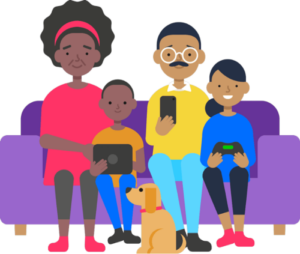Our newly released Refuge and Risk – Life Online for Vulnerable Young People report, explores how UK children with some form of vulnerability, show how the online world has become their lifeline.
As part of the Youthworks, over 6,500 UK children with some form of vulnerability shows the online world has become their lifeline – yet some are to up to seven times more likely to meet particular dangers over the internet than their non-vulnerable peers. This report is by Youthworks and Kingston University, in partnership with Internet Matters – calls for a number of urgent changes in the way vulnerable children receive support, including an approach that considers their offline vulnerability, and parents and professionals being encouraged to think differently about online safety advice for teens.
*From a sample of 14,449 11-17-year olds, of whom 6,500 self-identified as having one or more of five types of vulnerability.
We must protect the UK’s two million vulnerable children from online harm
We need to place a greater focus on how the UK supports vulnerable children, as a new study reveals some can be up to SEVEN TIMES more at risk in the digital world than those without vulnerabilities.
The Refuge and Risk report showed they face many and varied types of online risks. While their vulnerabilities make them more likely to experience risk than non-vulnerable teens, being without digital access can also be problematic. If they are harmed and become scared of going online, or have their device taken away, they lose opportunities to connect and develop socially, interacting with others without any label of vulnerability.
As a result, today we are calling for a new approach to support vulnerable young people so their online lives are fully considered in their education and care.
Facts and statistics
The study – part of an ongoing research programme– reveals that compared to teens without vulnerabilities, those with three or more vulnerabilities are:
- Four times more likely to experience cyberaggression risks including cyberbullying or racist/homophobic comments and insults (40% vs 11%)
- Three times more likely to be cyberscammed (14% vs 5%)
- Nearly three times more likely to see harmful content such as pro-anorexia, self-harm or talk about suicide than their non-vulnerable peers. (40% vs 15%)
Young people with eating disorders are most at risk
The report also found that those with eating disorders are most at risk, in a variety of ways, with almost a third (31%) having seen content about suicide ‘often’ in contrast to 4% of young people without vulnerabilities. Those with eating disorders were also most likely to say, ‘someone online tried to persuade me into sexual activity I did not want’ with 43% have ever experienced this, of whom 23% said it happened ‘often’, compared to 3% of their peers without vulnerabilities.
Teens with eating disorders were seven times more likely to say they have ‘often’ had a nude image shared in revenge by a former partner after a breakup (15% versus 2% for non-vulnerable teens).
This group were also the most likely to be cyberbullied among all the vulnerable groups (48%) and reported many signs of compulsion, with almost half (46%) becoming ‘irritated and anxious’ without their phone. This was in contrast to 15% of non-vulnerable teens.
Care-experienced young people
Care-experienced teens were found to have been subject to intense cyberaggression – nearly three in 10 (29%) had received messages threatening to harm them or their family, compared to just 9% of non-vulnerable teenagers. A third had ever fallen for an online scam and one in six (16%) said this happened ‘often’ – compared to 2% of non-vulnerable teens.
Whilst the risk of online harm is clear, the report highlights the importance of connectivity, social skills and development for vulnerable young people. For them, digital access is a gateway to ‘being like everyone else’.
Autistic young people
Nearly nine out of 10 (86%) autistic teens and 82% of teens with learning difficulties said ‘the internet ‘opens up lots of possibilities for me’ compared to 62% of children with no disabilities. As a result of the report, we recommend that children be routinely asked about their online lives by adults looking after them and for those conversations to be meaningful, which will require training, resources and investment.
It calls for education professionals and adults looking after vulnerable children to be brought up to date with meaningful online safety training, moving away from a one size fits all strategy.
Final words
Carolyn Bunting, CEO of Internet Matters, said: “The research shows children with vulnerabilities rely very significantly on their connected devices for communication, entertainment and support. The impulse of parents to protect them by stopping them going online is not the answer, as this may lead to a double-whammy for the child, taking away an important part of their personal and social life that they deeply rely on.
Instead, we need to create a culture where vulnerable young people are routinely asked about their online lives so they can carry on engaging, but safely. Online safety education as currently delivered doesn’t work for vulnerable children – and now we have the data to allow meaningful conversations to take place between them and trusted adults.
We want to work together with parents, carers, educational professionals and tech companies to ensure training and resources are brought up-to-date.”
Adrienne Katz, Director of Youthworks, who co-authored the report with Aiman El Asam of London’s Kingston University, said: “This report really highlights how much the online world offers both a refuge and risk to the most vulnerable children in our society.
It’s clear they depend on it, escape into it, and are deeply hurt or harmed when things go wrong. Therefore, it is of paramount importance that we look at meaningful ways we can make it a much safer experience for them.
We should urgently review training and resources surrounding vulnerable young people and move away from a one size fits all approach.”







